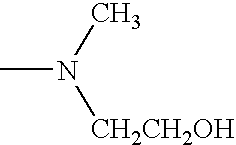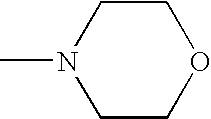Sustained release compositions and controlled delivery method
a composition and composition technology, applied in the direction of pharmaceutical active ingredients, pharmaceutical delivery mechanisms, toilet preparations, etc., can solve the problems of inadequate treatment as active agent concentrations drop, sharp increase in active agent concentration to a peak, and poor control of active agent concentration, so as to reduce the effect of premature displacement of active agents, reducing the effect of active agent concentration
- Summary
- Abstract
- Description
- Claims
- Application Information
AI Technical Summary
Benefits of technology
Problems solved by technology
Method used
Image
Examples
example 1
[0123] Adsorption capacity is the maximum weight percent of a liquid added to an adsorptive substrate (powder) until a very stiff, putty-like paste is produced. The adsorption capacity was determined by ASTM Method D 281-31, and the method disclosed in U.S. Pat. No. 4,962,170, incorporated herein by reference. In particular, the adsorption capacity is calculated from the weight difference of the powder containing the liquid and the dry powder according to the equation: Adsorption Capacity(%)=(wt. powder+liquid)-(initial wt. powder)×100(wt. powder+liquid)
[0124] In this test, EXPANCEL® 091 DE 40 d30 microspheres were tested for an ability to absorb water and mineral oil. It was found that the microspheres can absorb 20 grams of water per gram of particles (g / g) or 20 g / g of mineral oil.
example 2
[0125] EXPANCEL® 091 DE 40 d30 microspheres of median particle size 20 microns were loaded with an isopropanol / lutein solution to a content of 2 grams per gram, and dried in a vacuum oven at 40° C. to evaporate the isopropanol. The dry sustained release composition was an orange, fine powder, containing 20% by weight entrapped lutein, i.e., 0.25 grams per gram of microspheres. The entrapped lutein was delivered as a free-flowing powder, and was stabilized against oxidation and degradation by light.
example 3
[0126] A solution was prepared by dissolving 1 gram of urea peroxide in 1.5 grams of a water / acetone mixture. The solution was adsorbed on 1 gram of the EXPANCEL® 091 DE 40 d30 microspheres, then the water / acetone mixture was evacuated. The urea peroxide / microsphere sustained release composition was in form of a very fine, fluffy powder. Typically, urea peroxide is very unstable, shock sensitive, and deteriorates very quickly on contact with air humidity. The entrapped urea peroxide composition was stabilized and resisted degradation. The loading capacity of urea peroxide was 50 wt %, i.e., one gram per gram of microspheres.
PUM
| Property | Measurement | Unit |
|---|---|---|
| particle size | aaaaa | aaaaa |
| particle size | aaaaa | aaaaa |
| particle size | aaaaa | aaaaa |
Abstract
Description
Claims
Application Information
 Login to View More
Login to View More - R&D
- Intellectual Property
- Life Sciences
- Materials
- Tech Scout
- Unparalleled Data Quality
- Higher Quality Content
- 60% Fewer Hallucinations
Browse by: Latest US Patents, China's latest patents, Technical Efficacy Thesaurus, Application Domain, Technology Topic, Popular Technical Reports.
© 2025 PatSnap. All rights reserved.Legal|Privacy policy|Modern Slavery Act Transparency Statement|Sitemap|About US| Contact US: help@patsnap.com



